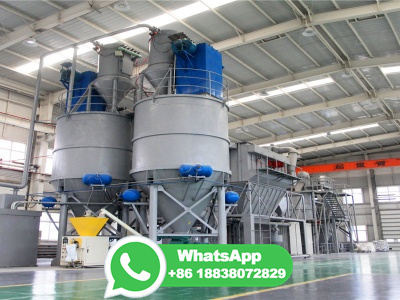
Bitumen occurs as a secondary organic matter generated during catagenesis due to (1) thermal cracking of kerogen in the initial/incipient oil window (exsudatinite is likely to be the maceral ...
WhatsApp: +86 18838072829
These data provide insights into the oil cracking mechanisms [8] and kinetic model for the generation of hydrocarbon gas, linking isotopic fractionation and molecular ... As the graphene quantum dots have been found in bituminous coal ... The formation process of coalderived graphite was the shrinking and extinction of primary structural ...
WhatsApp: +86 18838072829
Tursun et al. [56] carried out steam gasification of bituminous coal and saw dust blend at a temperature of 850 °C, The study reported that with the increase of gasification temperature, the tar yield decrease because, at higher temperature and olivine as a catalyst, the cracking and reforming reaction improved which leads to less tar ...
WhatsApp: +86 18838072829
article{osti_, title = {Hydrogenation of coal and tar}, author = {Wu, W and Storch, H H}, abstractNote = {This bulletin traces development of highpressure, coal and tar hydrogenation technology, based on an intensive review of pertinent literature. The bulletin written as part of the Bureau of Mines research program on synthetic liquid fuels covers the history and economics of ...
WhatsApp: +86 18838072829
How coal is formed and definitions of different types or ranks of coal: anthracite, bituminous, subbituminous, and lignite. ... Bituminous coal is used to generate electricity and is an important fuel and raw material for making coking coal or use in the iron and steel industry. Bituminous coal was produced in at least 16 states in 2021, but ...
WhatsApp: +86 18838072829
It was rediscovered back in 2005, on the one hand, to follow the trend set by Bergius of biomass to coal conversion for decentralised energy generation, and on the other hand as a novel green method to prepare advanced carbon materials and chemicals from biomass in water, at mild temperature, for energy storage and conversion and environmental ...
WhatsApp: +86 18838072829
Production of town gas and synthesis gas by pressure gasification of bituminous coal. [Thermodynamic conditions ad reaction kinetics for gasification of coal in a fixed bed at high pressure, and differences in process for gasification of coal dust at atm pressure and coal lumps under high pressure are discussed]
WhatsApp: +86 18838072829
Abstract Coalification is caused by temperature and pressure inherent to burial and is enhanced by geologic time and tectonism. Coalification processes include dehydration, bituminization, debituminization, and graphitization, which involve chemical and physical changes of organic matter.
WhatsApp: +86 18838072829
The formation process of CNTs is as follows: coal takes pyrolysis to produce small carboncontaining molecules such as CH 4, and the small carboncontaining molecules formed CNTs through catalytic cracking under the action of catalyst. A "stepwise growth" model of CNTs was established. ... we took bituminous coal as the raw material and ...
WhatsApp: +86 18838072829
Bitumen is a sticky, black, and highly viscous liquid or semisolid form of petroleum. It is often confused with asphalt and tar, but they are different materials. Asphalt is a mixture of bitumen and aggregates (stone, sand, gravel), whereas tar is a thick, dark liquid derived from the distillation of coal.
WhatsApp: +86 18838072829
syncrude from bitumen. Figure 2 is an image of petroleum coke showing different types and sizes of coke. Figure 2. Petroleum coke [4]. Coke can also be obtained from coal. There are two types of reactions that occur in the formation of coke from coal [5]. These are: 1. the cracking reactions, which consist of the rupture of carboncarbon bonds.
WhatsApp: +86 18838072829
The Bergius process is a method of production of liquid hydrocarbons for use as synthetic fuel by hydrogenation of highvolatile bituminous coal at high temperature and pressure. It was first developed by Friedrich Bergius in 1913. In 1931 Bergius was awarded the Nobel Prize in Chemistry for his development of highpressure chemistry.
WhatsApp: +86 18838072829
The process of formation of rocks is different for various rocks. Rocks are quarried from many years for various purposes. You can check out Coal vs Shale information and Coal vs Shale characteristics in the upcoming sections. ... The hardness of Coal is and that of Shale is 3. The types of Coal are Peat, Lignite, SubBituminous Coal ...
WhatsApp: +86 18838072829
Intensive studies on volatile formation mechanisms and its molecular distributions are of great significance to regulate CH 4 content in syngas during integrated coal gasification coupling pyrolysis system. Two bituminous coals were thoroughly characterized with FTIR and solidstate 13 C NMR to afford their bond structures and then pyrolytic volatiles were in depth explored with the ...
WhatsApp: +86 18838072829
Bituminous Coal Bituminous coal is formed under more heat and pressure, and is 100 million to 300 million years old. It is named after the sticky, ... In the United States, the Surface Mining Control and Reclamation Act of 1977 regulates the process of coal mining, and is an effort to limit the harmful effects on the environment. The act ...
WhatsApp: +86 18838072829
Characteristics of Bituminous Coal. Bituminous coal contains moisture of up to approximately 17%. About to 2 percent of the weight of bituminous coal is nitrogen. Its fixed carbon content ranges up to approximately 85 percent, with ash content up to 12% by weight. Bituminous coal can be categorized further by the level of volatile matter ...
WhatsApp: +86 18838072829
The maceral composition of coals is defined by many factors such as specific features of the coalification processes, the nature of the initial plant material and the conditions of its accumulation and decomposition (Epshtein et al., 2015). The carbon contain of coals varies from 65 to 95% depending on the degree of the coal metamorphism.
WhatsApp: +86 18838072829
It can be concluded that the pyrolysis of bituminous coal occurred with a certain delay, especially at the higher heating rates. As shown in Fig. 1 (a), the three stages for the bituminous coal pyrolysis process can be divided into dry degassing, active decomposition, and slow condensation. The first stage before 270℃ is a slow loss of mass.
WhatsApp: +86 18838072829
The upgraded coal (semicoke) can be utilized in ironmaking process. Thermogravimetry and DAEM were used to analyze the combustion kinetics of bituminous coal before and after modification in this study.
WhatsApp: +86 18838072829
Coal is a combustible rock mainly composed of carbon along with variable quantities of other elements, mostly hydrogen, sulphur, oxygen and nitrogen. Coal occurs as layers, called coal beds or coal seams, that are found between other sedimentary rocks. Coal is slightly denser than water but less dense than most of the rocks of the Earth's crust ...
WhatsApp: +86 18838072829
Experimental principle. To study the cracking characteristics induced by the SCCO 2 phase change in the microcracks of coal during SCCO 2 jet coal breaking, SEM was used to analyze the variation pattern of coal surface cracks and to determine whether a phase change fracture effect occurs in the process of SCCO 2 coal breaking. A laser particle size analyzer was used to analyze the ...
WhatsApp: +86 18838072829
Pyrolysis, as a process technology, has received considerable attention from many researchers because it is an important intermediate stage in coal conversion. Reactions parameters as the ...
WhatsApp: +86 18838072829
A process in which the Athabasca bitumen is thermally hydrocracked in the presence of pulverized coal (before contacting the usual forms of commercial hydro cracking catalyst) is being investigated at the Energy Research Laboratories as a technique for removing the coke forming compounds and reducing catalyst fouling. ... UP upper part formed ...
WhatsApp: +86 18838072829
Petroleum Formation, Maturation, Kerogen: Deeper burial by continuing sedimentation, increasing temperatures, and advancing geologic age result in the mature stage of hydrocarbon formation, during which the full range of petroleum compounds is produced from kerogen and other precursors by thermal degradation and cracking (in which heavy hydrocarbon molecules are broken up into lighter ...
WhatsApp: +86 18838072829
1. The methodfor the distillation of hituminous coal which comprises mixing the coal with a heavy hydrocarbon oil, heating themixture. under pressure, and then distilling the mixture at a pressure materially below 20 atmospheres to obtain a large proportion ofhydrocarbon oils from the coal with a small proportion of permanent gas. 2.
WhatsApp: +86 18838072829
Coal forms when swamp plants are buried, compacted and heated to become sedimentary rock in a process called coalification. "Very basically, coal is fossilized plants," James Hower, a...
WhatsApp: +86 18838072829
THE FORMATION OF COAL What is Coal? Coal is a combustible, sedimentary, organic rock formed from ancient vegetation, which has been consolidated between other rock strata and transformed by the combined effects of microbial action, pressure and heat over a considerable time. This process is referred to as 'coalification'.
WhatsApp: +86 18838072829
Consolidated Coal Company Inc. to the Bituminous Coal Division, Report of Analysis Used, May 24, 1943; Analysis Files, (NAID: 636954, HMS Entry ID: PH6550); Altoona; Records of the Bituminous Coal Division, Record Group 0222; National Archives and Records Administration, Philadelphia, PA. Thousands of marketing analyses like these make up a core component of the BCD records.
WhatsApp: +86 18838072829